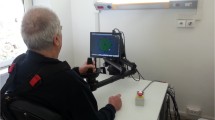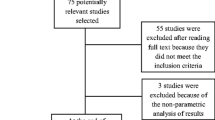Abstract
Objective
This study aims to find out whether including robotic therapy in addition to a conventional rehabilitation program affects the quality of life, motor function, cognition, and emotional status of hemiplegic patients.
Design
Thirty-seven stroke patients recruited between April 2016 and April 2019 were included in the study. The patients were randomized into 2 groups (Robotic rehabilitation group-RR n:17, Control group n:20), RR was arranged to be 30–45 min, 5 days per week for 4 weeks. All patients were assessed at the beginning of therapy and the end of 4th week with Brunnstrom stages of motor recovery, Fugl-Meyer Assessment (FMA), handgrip strength, Purdue peg test, Minnesota manual dexterity test, Modified Ashworth Scale (MAS), Functional Independence Measure (FIM), Stroke Specific Quality of Life Scale (SS-QOL), Nottingham Extended Activities of Daily Living (NEADL) Scale, Montreal Cognitive Assessment (MoCA) and Center for Epidemiological Studies Depression Scale (CES- D).
Results
Improvements in motor function scores, spasticity, general functioning, activities of daily living, cognitive assessment were better in the robotic group when compared to the control group but this difference was not statistically significant (p > 0.05).
Improvement in the CES-D in the RR-group was better in comparison to the control group (p = 0.018).
Conclusion
Improvements in motor functions were observed after the treatment in both groups. Although RR group improved better in numbers, none of the outcomes except the CES-D scale were significant. Robotic rehabilitation provides a favorable alternative bringing slight benefits, and also is advantageous in terms of work power and psychological recovery, making its addition to conventional neurological rehabilitation effective and useful in patient management after stroke.
Trial registration
ClinicalTrials.gov Identifier: NCT04393480


Similar content being viewed by others
Change history
06 March 2023
A Correction to this paper has been published: https://doi.org/10.1007/s10072-023-06723-x
References
Teasell R, Foley N et al (2009) Evidence-based review of stroke rehabilitation: executive summary. Top Stroke Rehabil 16(6):463–488
Schönberger M, Humle F et al (2006) Patient compliance in brain injury rehabilitation in relation to awareness and cognitive and physical improvement. Neuropsychol Rehabil 16(5):561–578
Tu W-J, Qiu H-C et al (2018) Decreased concentration of irisin is associated with poor functional outcome in ischemic stroke. Neurotherapeutics 15(4):1158–1167
Norouzi-Gheidari N, Archambault PS et al (2012) Effects of robot-assisted therapy on stroke rehabilitation in upper limbs: systematic review and meta-analysis of the literature. J Rehabil Res Dev 49(4):479
Rosati G, Oscari F, et al (eds) (2011) Improving robotics for neurorehabilitation: enhancing engagement, performance, and learning with auditory feedback. Rehabilitation Robotics (ICORR), 2011 IEEE International Conference on: IEEE
Aisen ML, Krebs HI et al (1997) The effect of robot-assisted therapy and rehabilitative training on motor recovery following stroke. Arch Neurol 54(4):443–446
Lo AC, Guarino PD et al (2010) Robot-assisted therapy for long-term upper-limb impairment after stroke. N Engl J Med 362(19):1772–1783
Paolucci T, Agostini F, Mangone M, Bernetti A, Pezzi L, Liotti V, Recubini E, Cantarella C, Bellomo RG, D’Aurizio C, Saggini R (2021) Robotic rehabilitation for end-effector device and botulinum toxin in upper limb rehabilitation in chronic post-stroke patients: an integrated rehabilitative approach. Neurol Sci. https://doi.org/10.1007/s10072-021-05185-3
Nef T, Klamroth-Marganska V, Keller U, Riener R (2016) Three-dimensional multi-degree-of-freedom arm therapy robot (ARMin). In: Neurorehabilitation technology. Springer, Cham, pp 351–374
Chang WH, Kim Y-H (2013) Robot-assisted therapy in stroke rehabilitation. Journal of stroke 15(3):174
Lum PS, Burgar CG et al (2002) Robot-assisted movement training compared with conventional therapy techniques for the rehabilitation of upper-limb motor function after stroke. Arch Phys Med Rehabil 83(7):952–959
Teasell R, Bayona N, Bitensky J (2016) Background concepts in stroke rehabilitation. Evidence-based review of stroke rehabilitation. Heart and Stroke Foundation Canadian Partnership for Stroke Recovery
Stefan K, Kunesch E et al (2000) Induction of plasticity in the human motor cortex by paired associative stimulation. Brain 123(3):572–584
Calabrò RS, Naro A et al (2018) Shaping neuroplasticity by using powered exoskeletons in patients with stroke: a randomized clinical trial. J Neuroeng Rehabil 15(1):1–16
Aprile I, Guardati G et al (2020) Robotic rehabilitation: an opportunity to improve cognitive functions in subjects with stroke. An explorative study. Front Neurol 11:1498
Charalambous CP (2014) Interrater reliability of a modified Ashworth scale of muscle spasticity. In: Classic papers in orthopaedics. Springer, London, pp 415–417
Linacre JM, Heinemann AW et al (1994) The structure and stability of the Functional Independence Measure. Arch Phys Med Rehabil 75(2):127–132
Küçükdeveci AA, Yavuzer G et al (2001) Adaptation of the Functional Independence Measure for use in Turkey. Clin Rehabil 15(3):311–319
Green J, Young J (2001) A test-retest reliability study of the Barthel Index, the Rivermead Mobility Index, the Nottingham Extended Activities of Daily Living Scale and the Frenchay Activities Index in stroke patients. Disabil Rehabil 23(15):670–676
Sahin F, Yilmaz F et al (2008) Reliability and validity of the Turkish version of the Nottingham Extended Activities of Daily Living Scale. Aging Clin Exp Res 20(5):400–405
Gladstone DJ, Danells CJ et al (2002) The Fugl-Meyer assessment of motor recovery after stroke: a critical review of its measurement properties. Neurorehabil Neural Repair 16(3):232–240
Tiffin J, Asher EJ (1948) The Purdue Pegboard: norms and studies of reliability and validity. J Appl Psychol 32(3):234–247
Desrosiers J, Rochette A et al (1997) The Minnesota Manual Dexterity Test: reliability, validity and reference values studies with healthy elderly people. Can J Occup Ther 64(5):270–276
Williams LS, Weinberger M et al (1999) Development of a stroke-specific quality of life scale. Stroke 30(7):1362–1369
Nasreddine ZS, Phillips NA et al (2005) The Montreal Cognitive Assessment, MoCA: a brief screening tool for mild cognitive impairment. J Am Geriatr Soc 53(4):695–699
Hann D, Winter K et al (1999) Measurement of depressive symptoms in cancer patients: evaluation of the Center for Epidemiological Studies Depression Scale (CES-D). J Psychosom Res 46(5):437–443
Tatar A, Saltukoglu G (2010) The adaptation of the CES-depression scale into Turkish through the use of confirmatory factor analysis and item response theory and the examination of psychometric characteristics. Klinik Psikofarmakoloji Bülteni-Bulletin of Clinical Psychopharmacology 20(3):213–227
Masiero S, Armani M et al (2013) Randomized trial of a robotic assistive device for the upper extremity during early ınpatient stroke rehabilitation. Neurorehabil Neural Repair 28(4):377–386
Klamroth-Marganska V, Blanco J et al (2014) Three-dimensional, task-specific robot therapy of the arm after stroke: a multicentre, parallel-group randomised trial. The Lancet Neurology 13(2):159–166
Takahashi K, Domen K et al (2016) Efficacy of upper extremity robotic therapy in subacute poststroke hemiplegia. Stroke 47(5):1385–1388
Tomić TJD, Savić AM et al (2017) ArmAssist robotic system versus matched conventional therapy for poststroke upper limb rehabilitation: a randomized clinical trial. Biomed Res Int 2017:1–7
Bertani R, Melegari C et al (2017) Effects of robot-assisted upper limb rehabilitation in stroke patients: a systematic review with meta-analysis. Neurol Sci 38(9):1561–1569
Veerbeek JM, Langbroek-Amersfoort AC et al (2016) Effects of robot-assisted therapy for the upper limb after stroke. Neurorehabil Neural Repair 31(2):107–121
Prange GB, Jannink MJA et al (2006) Systematic review of the effect of robot-aided therapy on recovery of the hemiparetic arm after stroke. The Journal of Rehabilitation Research and Development 43(2):171
Zhang C, Li-Tsang CWP et al (2017) Robotic approaches for the rehabilitation of upper limb recovery after stroke: a systematic review and meta-analysis. Int J Rehabil Res 40(1):19–28
Zengin-Metli D, Özbudak-Demir S et al (2018) Effects of robot assistive upper extremity rehabilitation on motor and cognitive recovery, the quality of life, and activities of daily living in stroke patients. J Back Musculoskelet Rehabil 31(6):1059–1064
Adomavičienė A, Daunoravičienė K et al (2019) Influence of new technologies on post-stroke rehabilitation: a comparison of armeo spring to the kinect system. Medicina 55(4):98
Author information
Authors and Affiliations
Contributions
Taravati Sahel: concepts, design, literature search, clinical studies, data acquisition, manuscript preparation.
Karapolat Hale: concepts, design, literature search, manuscript preparation, data analysis, manuscript review.
Capaci Kazim: concepts, design, clinical studies, data acquisition, manuscript preparation.
Tanigor Goksel: literature search, data analysis, manuscript editing, manuscript review analysis, manuscript review.
This manuscript has been read and approved by all the authors, the requirements for authorship have been met, and each author declares that the manuscript represents honest work.
Corresponding author
Ethics declarations
Ethics approval
The study protocol was approved by the ethics committee of Ege University Faculty of Medicine Institutional Review Board.
Informed consent
Informed consent was obtained from all individual participants included in the study.
Conflict of interest
The authors declare no competing interests.
Additional information
Publisher’s note
Springer Nature remains neutral with regard to jurisdictional claims in published maps and institutional affiliations.
Rights and permissions
Springer Nature or its licensor (e.g. a society or other partner) holds exclusive rights to this article under a publishing agreement with the author(s) or other rightsholder(s); author self-archiving of the accepted manuscript version of this article is solely governed by the terms of such publishing agreement and applicable law.
About this article
Cite this article
Taravati, S., Capaci, K., Uzumcugil, H. et al. Evaluation of an upper limb robotic rehabilitation program on motor functions, quality of life, cognition, and emotional status in patients with stroke: a randomized controlled study. Neurol Sci 43, 1177–1188 (2022). https://doi.org/10.1007/s10072-021-05431-8
Received:
Accepted:
Published:
Issue Date:
DOI: https://doi.org/10.1007/s10072-021-05431-8




